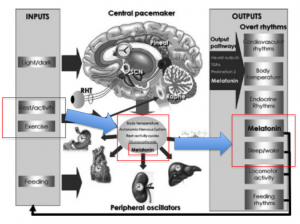The main idea of the graph is that Exercise (first red box) affects a variety of things (second red box), such as melatonin(shown in red). The graph then shows that because exercise affects melatonin levels, which are connected with the sleep/wake cycle(last red box), exercise affects sleep patterns.
Citation:
Escames, G., Ozturk, G., Baño-Otálora, B., Pozo, M. J., Madrid, J. A., Reiter, R. J., & … Acuña-Castroviejo, D. (2012). Exercise and melatonin in humans: reciprocal benefits. Journal Of Pineal Research, 52(1), 1-11. doi:10.1111/j.1600-079X.2011.00924.x
Goal:
The goal of the study was to show how exercise might affect melatonin rhythms and that increased physical exercise can actually improve many everyday activities and keep circadian rhythms in sync.
Hypothesis:
Exercise can affect melatonin levels in a way that can increase physical performance by keeping circadian rhythms in the body leveled.
Measured:
The role of melatonin was measured and the effect of physical exercise on the circadian rhythms was measured.
Figure:
This figure shows the effect that melatonin and exercise has on the circadian system. This figure shows circadian clocks, inputs, and outputs, which are three of the major components of the hypothalamus. This figure supports the hypothesis because the figure clearly demonstrates how exercise can effect melatonin which then can effect the circadian rhythms.
Findings:
The researchers concluded that according to the data it is clear that exercise and melatonin have a large effect of circadian rhythms.
Question:
How does the intensity of the exercise correspond to melatonin levels?


